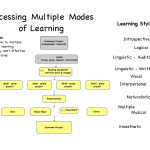“The contrast between the enormous popularity of the learning-styles approach within education and the lack of credible evidence for its utility is, in our opinion, striking and disturbing,” — Pasher et al., 2008.
What if there was no such thing as learning styles? What if tests were a great way to help students learn? Benedict Carey has a fascinating article in the New York Times that reviews some of the cognitive and educational research on how students learn.
Among the more interesting findings are that there is practically no evidence that different learning styles make a difference in learning (though this is largely because there aren’t any good studies the met the stringent criteria of the authors’ of this review). The pattern of work in our Montessori Middle School program is designed around the idea that different students have predilections for certain types of learning. And my own anecdotal observations, of myself and of my students, indicate that this is the case. However, even if learning styles were not important at all, Carey’s article points out another observation that highlight the power of our approach.

First off, though we believe different students have different learning styles, the cycle of work is designed to expose all students to multiple learning styles. So the belief in learning styles is not stifling. If students do learn better from reading, they get the chance, but for any given topic and on any given week, they’ll see the same information in diagrams and get to talk it over with their small group. This ties into Carney’s observation that varying the study environment, and the information studied, aids learning. For example, in the case of identifying different painters by looking at their work:
“What seems to be happening … is that the brain is picking up deeper patterns when seeing assortments …; it’s picking up what’s similar and what’s different about them,” — Nate Kornell (in Carney, 2010)
Overspecification is something I wonder about when I hear about the School of One program in New York City, which I discovered via the Freakonomics podcast. (I’ll post more on this intriguing program later).
Carney also points out the research that shows that testing helps students learn. But here the important point to highlight is that it testing is most effective when it’s used as a formative assessment, when it helps guide learning, and when it is used to reinforce ideas students are learning. This is how I use our cycle tests. Summative tests, like standardized tests, which try in one big lump to assess a student’s learning, are susceptible to so many small variabilities and are so prone to overinterpretation and overemphasis that it’s hard to say that their benefits overweight their problems.
It is important that, as teachers, we remain cognizant of the educational research. But it’s just as important the we not just jump on the latest fads or get overexcited about the latest research results. The Montessori Middle School program is constantly evolving, but it has a long and successful history, so it behooves us to approach the research with caution and to dig beneath the surface to see if the results are really fundamental at odds with what we know (at least in our experience) works.